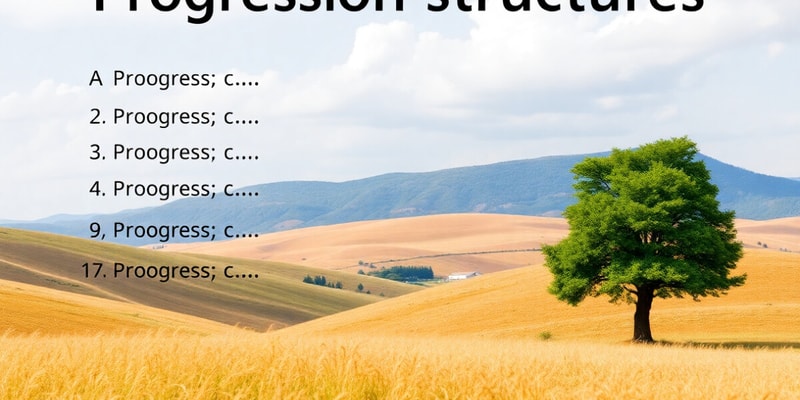Podcast Beta
Questions and Answers
Which of the following sentences demonstrates the use of a past perfect progressive structure?
The present progressive structure indicates completed actions.
False
What auxiliary verb is used to form progressive verb structures?
be
I _____ (wait) for my friend when I saw her at the park.
Signup and view all the answers
Match each progressive structure with its correct description:
Signup and view all the answers
Which of the following sentences demonstrates a less direct request using a progressive verb form?
Signup and view all the answers
The verb 'see' can be used in a progressive form like 'I am seeing the doctor at ten o'clock'.
Signup and view all the answers
Name one verb that expresses a mental state and is not used in progressive forms.
Signup and view all the answers
I ____ my keys on the table. (Use the correct form of the verb 'know')
Signup and view all the answers
Match the following verbs with their corresponding category:
Signup and view all the answers
Which verb forms can be used with 'can' to express a sense of progression?
Signup and view all the answers
The sentence 'I'm always losing my keys' indicates a planned action.
Signup and view all the answers
What is the structure used to create perfect verb forms?
Signup and view all the answers
To express repeated actions, the progressive form can be used with words like '_________' or 'continually'.
Signup and view all the answers
Match the perfect verb forms with their corresponding examples:
Signup and view all the answers
Which of the following verbs is categorized as a communicating verb?
Signup and view all the answers
Verbs like 'smell' and 'taste' can only be used in the progressive form.
Signup and view all the answers
What does the non-progressive use of the verb 'feel' typically express?
Signup and view all the answers
They _____ (own) a beautiful house.
Signup and view all the answers
Match each verb to its correct category.
Signup and view all the answers
What is the primary function of the perfect verb form?
Signup and view all the answers
A subject can be dropped in all grammatical structures.
Signup and view all the answers
Give an example of a transitive verb.
Signup and view all the answers
In the sentence 'The wind is _____ the curtain,' the verb is considered _____ because it does not require a direct object.
Signup and view all the answers
Match each type of verb with its correct definition:
Signup and view all the answers
Study Notes
Progressive Structures
- Progressive verb structures are formed using "be" + the "-ing" form of the main verb.
- They express ongoing actions that are temporary and not necessarily complete.
- Some verbs, like "know," "like," and "believe," are typically not used in progressive forms when expressing states rather than actions.
Distancing
- Progressive structures can make requests, questions, and statements less direct.
- They sound less definite than simple forms, suggesting something temporary and incomplete.
-ing Forms
- Verbs that are usually not used in progressive forms can take the "-ing" form in other structures, such as "Knowing her tastes, I bought her a large box of chocolates."
Perfect Structures
- Perfect verb forms are created using "have" + the past participle of the verb.
- Perfect forms typically indicate an event occurring earlier than another time, past, present, or future.
- Combining perfect and progressive forms can create nuanced descriptions of actions that started in the past and continued until a particular point.
Subject and Objects
- Subjects typically precede verbs in a statement and indicate the agent (the person or thing causing the action).
- Some verbs are transitive, requiring a direct object to indicate what is affected by the action (e.g., "invite," "surprise").
- Other verbs are intransitive and do not require a direct object (e.g., "sit," "sleep").
Communicating and Causing Reactions
- Verbs used for communicating often describe actions involving thoughts, beliefs, or statements.
- Verbs used for causing reactions often describe how actions affect individuals or objects.
Verbs with Both Active and Passive Meanings
- Some verbs can be used transitively (with an object) or intransitively (without an object).
- The intransitive form often has a passive or reflexive meaning.
Indirect Objects
- Indirect objects indicate who or what receives something and can be placed after the direct object, often with a preposition (to or for).
- For example, "I gave the keys to Jack."
- When both objects are pronouns, the indirect object is typically placed last, such as "Lend them to her."
- In wh-questions about indirect objects, the preposition is usually included, such as "Who did you buy it for?"
- In passive structures, the receiver of the action is often the subject.
Verb + Object + Complement
- Some transitive verbs can be followed by an object and an object complement, which provides additional information about the object.
- This object complement is often an adjective or noun phrase.
Complements of Place
- After specific verbs, expressions of place can directly follow the object without a preposition.
- For example, "I like climbing mountains" is correct, but "I like climbing on mountains" is not.
Linking Verbs
- Linking verbs connect the subject of a sentence to a subject complement, which describes the subject.
- These verbs include "be," "seem," "appear," "look," "feel," "sound," "taste," and "become."
Verbs with Two Objects
- Many verbs can have two objects—typically a person and a thing.
- These verbs often relate to transferring or communicating things from one person to another.
Introducing It
- When the object of a verb is a clause, infinitive structure, or -ing structure, and there is an object complement, it's common to use "it" as a preparatory object.
- For example, "She made her views clear" can be rewritten as "She made it clear that she disagreed."
Direct and Indirect Objects
- Some verbs can have two objects: a direct object and an indirect object.
- The direct object is the thing that is given, sent, bought, etc.
- The indirect object is the person who receives the direct object.
- Most often, the indirect object comes before the direct object.
- Examples of verbs that can take two objects include: bet, bring, build, buy, cost, give, leave, lend, make, owe, pass, pay, play, promise, read, refuse, send, show, sing, take, teach, tell, throw, wish and write.
- For example: I bet you ten dollars. "You" is the indirect object and "ten dollars" is the direct object.
- Another example: He built the children a tree house. "The children" is the indirect object and "a tree house" is the direct object.
Studying That Suits You
Use AI to generate personalized quizzes and flashcards to suit your learning preferences.
Description
Test your understanding of progressive and perfect verb structures in English. This quiz covers how to form progressive verbs, their uses, and the contrast with perfect forms. Gain insight into the nuances of using these structures in various contexts.




